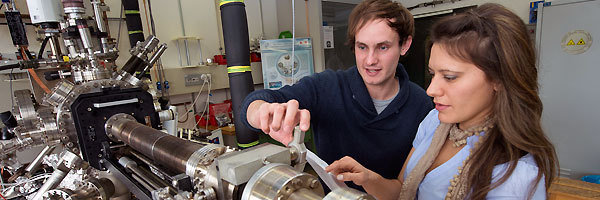
Nanostructures that take after nature
Life is impossible without nanotechnology. Nature has always followed the principles that are also being increasingly utilised today in technical applications. The Max Planck-EPFL Center for Molecular Nanosciences and Technology conducts interdisciplinary research in bio- and nanotechnology. The properties of the new materials being investigated are determined by their nanostructure.
In addition to a team of scientists headed by Klaus Kern, Director at the Max Planck Institute for Solid State Research in Stuttgart and by Thomas Rizzo, Professor of Natural Sciences on the Faculty of the École Polytechnique Fédérale de Lausanne (EPFL), the Max Planck Institutes of Biophysical Chemistry in Göttingen and for Intelligent Systems in Stuttgart, the Fritz Haber Institute of the Max Planck Society in Berlin and the EPFL Faculties for Life Sciences and Engineering Sciences at the Max Planck-EPFL Center will also be participating. An important focus of Center is the multi-disciplinary training of junior scientists at its own graduate school. This is a unique characteristic of the Center, as is having its own laboratory which will be built on the EPFL campus.
The researchers at the Center want to uncover the underlying principles that connect a material’s properties to its molecular structure. They also want to identify which physical quantities and scales control the structure and its properties. In addition, the cooperating partners are blazing new trails in bionanotechnology leading to potential applications in medicine and pharmacology. Chemists, physicists, biologists and engineers are working together at the Center towards these goals.
Molecular identification is pivotal for biological processes and molecular nanoscience. Nature implements these processes perfectly and sets the bar for technology: enzymes always process the correct reactant, antibodies continually and reliably locate antigens, and cells are remarkably sensitive to their environment. Since insights into molecular identification could potentially enable creation of complex, specialized nanosystems for nano- and biotechnologies, their mechanisms represent a central research subject at the Center.
Using a bottom-up approach, researchers at the Max Planck – EPFL laboratory use molecular identification to build nanostructures. To this effect, molecules arrange themselves, under suitable conditions, in a self-organising manner into the desired structures, similar to how biological materials form. Just which conditions are most suitable for this process is a question that the researchers in Lausanne will be pursuing. Moreover, scientists in the lab are researching the fundamental mechanisms of energy exchange between molecules. These exchanges are relevant for numerous technical applications, for example the splitting of water into hydrogen and oxygen or photocatalysis, with which the energy contained in sunlight could be transformed into chemical energy, just as plants do.
Picture: Researcher Magali Lingenfelder explains the technical equipment in the laboratory at EFL. © dpa/MPG